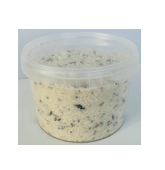Information for children and their carers
This leaflet is designed for families with children who have attended a ketogenic assessment clinic and are considering the modified ketogenic diet (MKD).
What is a ketogenic diet?
A ketogenic diet (KD) is an unnatural and medically supervised high fat diet, which is very low in carbohydrate and contains enough protein for normal growth. It is used as a treatment for drug-resistant epilepsy and specific metabolic conditions.
What is the modified ketogenic diet (MKD)?
The MKD is one of three main types of KD. It is similar to the low carbohydrate weight loss diet known as the ‘Atkins Diet’; however, a measured amount of fat is added to each meal so that the child continues to gain weight appropriately. In contrast to the MCT (medium-chain triglyceride) KD, it does not require any MCT fat supplements.
The quantity of fat and carbohydrate needed in the diet will be calculated by the dietitian. These amounts have been carefully calculated for each child dependent on their age, eating preferences and activity levels.
How much carbohydrate is allowed on the MKD?
The dietitian will calculate how much carbohydrate is required each day.
Foods such as bread, pasta, cereal, potatoes, rice and some fruits are high in carbohydrate and need to be limited. Carbohydrate is also found in dairy products and starchy vegetables. A lot of children and young people following the MKD use lower carbohydrate alternatives to bread, pasta and cereal. Some suggestions of these products can be found in this booklet and in the ‘Getting ready to start ketogenic diet therapy’ information sheet.
To help with meal planning, the carbohydrate allowance will be broken down into ‘exchanges’. The dietitian will explain how to use carbohydrate exchanges to make up meals.
How much fat is needed on the diet?
As with carbohydrate, the dietitian will calculate how much fat is required each day.
Foods such as butter, oil, nuts, pesto, avocado, cream and mayonnaise are good sources of fat. A prescribed amount of fat will be needed with each meal and snack.
To help with meal planning, the fat allowance will be broken down into ‘exchanges’. The dietitian will explain how to use fat exchanges in meals.
Are there any foods that can be eaten freely?
These foods and drinks are allowed freely on the modified ketogenic diet:
| Vegetables |
Celery, Bamboo shoots, Cucumber, Curly kale, Lettuce, Mustard and cress, Mushrooms, Radish, Sauerkraut, Spinach, Olives and Watercress |
|
|---|---|---|
| Fruits | Rhubarb (stewed without sugar), Lemon and lime | |
| Other | Salt, pepper, herbs, spices, Bovril, Marmite, stock cubes, oxo cubes, Soy sauce (up to 1 tablespoon), Worcester sauce, Tabasco, Vinegar, Sugar-free jelly, sugar-free pastilles in limited quantities and Ice lollies made from sugar-free squash | |
| Meats | All meats (including beef, salami, bacon, pork, pepperoni, lamb, veal and poultry) and fish. | |
| Eggs | All eggs (including fried, scrambled and poached) and omelettes. | |
| Cheese | All cheese, including brie, camembert, hard cheese, blue cheese, mozzarella, full fat cream cheese and parmesan. | |
| Drinks | Tea and coffee (without milk), sugar-free squash, sugar-free fizzy drinks, mineral or tap water, unsweetened almond milk, unsweetened soya milk and unsweetened coconut milk. | |
Are there any ketogenic products available on prescription that can be used?
There are several fat supplements and low carbohydrate alternatives available on prescription for children and young people on the ketogenic diet, including:





What are the side effects of ketogenic diet therapy?
| More common side effects | |
|---|---|
| Constipation | Constipation is usually managed with a carbohydrate-free laxative, called Movicol. Dietary adjustments can also help. |
| Reflux/ vomiting | Up to a third of children can experience a worsening of reflux or vomiting on KDT. The dietitian will advise on dietary adjustments if this becomes a problem. |
| Low blood sugars (hypoglycaemia)/ high ketones (hyperketosis) | As the body starts to adapt to a lower carbohydrate diet, or in times of illness, there is a risk of having low blood sugar levels. Ketones may also be too high. The dietitian will explain how to identify signs of low blood sugar levels and signs of high ketones and how to treat them both. |
| Micronutrient deficiencies |
The neurology team will check the blood’s vitamin and mineral levels before starting the diet; the dietitian may suggest a regular supplement. These blood tests will be repeated every six months. |
| Increased levels of fat in the blood | The neurology team will monitor the blood levels of fat (cholesterol and triglycerides) while on KDT. These levels may increase when starting KDT; however, they often return to normal with time. Dietary modifications can also help to achieve healthy levels. |
| Uncommon side effects include kidney stones, slowing of growth, and bone fractures. These are more of a risk for children who remain on the diet longer-term and will be monitored by the neurology team. |
We are smoke-free
Smoking is not allowed anywhere on the hospital campus. For advice and support in quitting, contact your GP or the free NHS stop smoking helpline on 0800 169 0 169.
Other formats
Help accessing this information in other formats is available. To find out more about the services we provide, please visit our patient information help page (see link below) or telephone 01223 256998. www.cuh.nhs.uk/contact-us/accessible-information/
Contact us
Cambridge University Hospitals
NHS Foundation Trust
Hills Road, Cambridge
CB2 0QQ
Telephone +44 (0)1223 245151
https://www.cuh.nhs.uk/contact-us/contact-enquiries/

